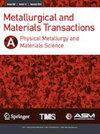Experimental and Numerical Investigation of a Solidification-Based Aluminum-Cooled Finger Refinement Process From Micro to Macro-Scale
IF 2.5
3区 材料科学
Q3 MATERIALS SCIENCE, MULTIDISCIPLINARY
Metallurgical and Materials Transactions A-Physical Metallurgy and Materials Science
Pub Date : 2023-08-03
DOI:10.1007/s11661-023-07147-0
引用次数: 0
Abstract
Abstract The interest in ultra-pure metals is steadily growing due to the increasing demand for these materials in modern technology. To be able to meet the increasing demand in the future, it is necessary to implement more efficient and productive processes. As a fractional crystallization method in this application area, the cooled finger method exhibits higher productivity and lower energy requirements when compared to industry well-established methods like zone melting. In this study, the mechanisms and relevant phenomena crucial for a successful implementation of a cooled finger process were investigated using a multidisciplinary approach. With carefully selected process parameters, we present here an experimental setup with a purification potential of approximately 80 pct. Additional micro- and macro-scale simulations demonstrate that the process is sensitive to parameters such as rotation rate, cooling rate, and temperature gradient within the melt, which explains the difficulty in optimizing this process in practice. An analysis and description of various phenomena that characterize the behavior of the cooled finger process are presented within this multi-scale approach. As a result, these approaches can also be transferred to the description of processes for other metals, opening application areas outside of the purification of aluminum.基于凝固的铝冷却手指细化过程从微观到宏观的实验与数值研究
由于现代技术对超纯金属的需求不断增加,人们对超纯金属的兴趣正在稳步增长。为了能够满足未来不断增长的需求,有必要实施更有效和更有生产力的流程。作为该应用领域的分式结晶方法,与区域熔化等行业成熟的方法相比,冷却手指法具有更高的生产率和更低的能量需求。在这项研究中,机制和相关现象至关重要的一个成功的实施冷却手指过程进行了研究,采用多学科的方法。通过精心选择的工艺参数,我们在这里展示了一个净化潜力约为80%的实验装置。额外的微观和宏观尺度模拟表明,该工艺对熔体内的旋转速率、冷却速率和温度梯度等参数很敏感,这解释了在实践中优化该工艺的困难。在这种多尺度方法中,分析和描述了表征冷却手指过程行为的各种现象。因此,这些方法也可以转移到其他金属的工艺描述中,开辟了铝净化以外的应用领域。
本文章由计算机程序翻译,如有差异,请以英文原文为准。
求助全文
约1分钟内获得全文
求助全文
来源期刊
CiteScore
5.30
自引率
7.10%
发文量
322
审稿时长
6 months
期刊介绍:
Metallurgical and Materials Transactions A focuses on the latest research in all aspects of physical metallurgy and materials science. It explores relationships among processing, structure, and properties of materials; publishes critically reviewed, original research of archival significance.
The journal address the main topics of alloy phases; transformations; transport phenomena; mechanical behavior; physical chemistry; environment; welding & joining; surface treatment; electronic, magnetic & optical material; solidification; materials processing; composite materials; biomaterials; and light metals. MMTA publishes Technical Publications, Communications, Symposia, and more.
Published with ASM International, The Materials Information Society and The Minerals, Metals & Materials Society (TMS)

 求助内容:
求助内容: 应助结果提醒方式:
应助结果提醒方式:


